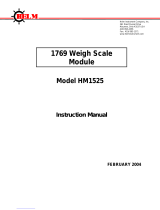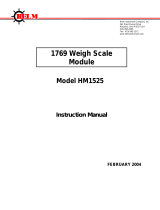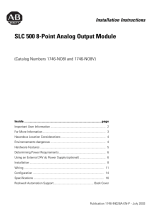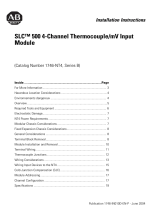Page is loading ...

SLC 500™ RTD/Resistance Input
Module
(Catalog Number 1746-NR4)
Installation Instructions
Inside… page
Important User Information . . . . . . . . . . . . . . . . . . . . . . . . . . . . . . . . . . . . . . . . . . . 2
For More Information . . . . . . . . . . . . . . . . . . . . . . . . . . . . . . . . . . . . . . . . . . . . . . . . 3
Overview . . . . . . . . . . . . . . . . . . . . . . . . . . . . . . . . . . . . . . . . . . . . . . . . . . . . . . . . . 4
Required Tools and Equipment . . . . . . . . . . . . . . . . . . . . . . . . . . . . . . . . . . . . . . . . 5
Electrostatic Damage. . . . . . . . . . . . . . . . . . . . . . . . . . . . . . . . . . . . . . . . . . . . . . . . 6
NR4 Power Requirements. . . . . . . . . . . . . . . . . . . . . . . . . . . . . . . . . . . . . . . . . . . . 6
Modular Chassis Considerations. . . . . . . . . . . . . . . . . . . . . . . . . . . . . . . . . . . . . . . 7
Fixed Expansion Chassis Considerations . . . . . . . . . . . . . . . . . . . . . . . . . . . . . . . . 7
General Considerations. . . . . . . . . . . . . . . . . . . . . . . . . . . . . . . . . . . . . . . . . . . . . . 7
Module Installation and Removal. . . . . . . . . . . . . . . . . . . . . . . . . . . . . . . . . . . . . . . 8
Terminal Block Wiring and Removal . . . . . . . . . . . . . . . . . . . . . . . . . . . . . . . . . . . . 9
Wiring Considerations . . . . . . . . . . . . . . . . . . . . . . . . . . . . . . . . . . . . . . . . . . . . . . . 10
Wiring Resistance Devices (Potentiometers) to the NR4 Module . . . . . . . . . . . . . . 13
Wiring Input Devices to the NR4 Module. . . . . . . . . . . . . . . . . . . . . . . . . . . . . . . . . 16
Module Addressing . . . . . . . . . . . . . . . . . . . . . . . . . . . . . . . . . . . . . . . . . . . . . . . . . 17
Channel Configuration. . . . . . . . . . . . . . . . . . . . . . . . . . . . . . . . . . . . . . . . . . . . . . . 17
Specifications. . . . . . . . . . . . . . . . . . . . . . . . . . . . . . . . . . . . . . . . . . . . . . . . . . . . . . 20
AB Spares

2 SLC 500™ RTD/Resistance Input Module
Publication 1746-5.17
Important User Information
Because of the variety of uses for the products described in this publication, those
responsible for the application and use of this control equipment must satisfy
themselves that all necessary steps have been taken to assure that each
application and use meets all performance and safety requirements, including any
applicable laws, regulations, codes and standards.
The illustrations, charts, sample programs and layout examples shown in this
guide are intended solely for purposes of example. Since there are many
variables and requirements associated with any particular installation, Allen-
Bradley does not assume responsibility or liability (to include intellectual
property liability) for actual use based upon the examples shown in this
publication.
Allen-Bradley publication SGI-1.1, Safety Guidelines for the Application,
Installation, and Maintenance of Solid-State Control (available from your local
Allen-Bradley office), describes some important differences between solid-state
equipment and electromechanical devices that should be taken into consideration
when applying products such as those described in this publication.
Reproduction of the contents of this copyrighted publication, in whole or in part,
without written permission of Allen-Bradley Company, Inc., is prohibited.
Throughout these installation instructions we use notes to make you aware of
safety considerations:
Attention statements help you to:
• identify a hazard
• avoid the hazard
• recognize the consequences
!
ATTENTION: Identifies information about practices or
circumstances that can lead to personal injury or death, property
damage or economic loss.
Important:
Identifies information that is critical for successful application and
understanding of the product.

SLC 500™ RTD/Resistance Input Module 3
Publication 1746-5.17
For More Information
As part of our effort to preserve, protect, and improve our environment, Allen-
Bradley is reducing the amount of paper we use. Less paper means more options
for you. In addition to traditional printed publications and CD-ROM versions, we
now offer on-line manuals with the most up-to-date information you can get. We
recommend that you read the related publications listed below before starting up
your control system.
Related Publications
How to Get More Information
If you would like a manual, you can:
• download a free electronic version from the internet at
www.theautomationbookstore.com
• purchase a printed manual by:
— contacting your local distributor or Rockwell Automation
representative
— visiting www.theautomationbookstore.com and placing your order
— calling 1.800.963.9548 (USA/Canada) or 001.330.725.1547 (Outside
USA/Canada)
For Refer to this Document Pub. No.
A more detailed description on how to install
and use your RTD/Resistance Input Module.
SLC 500™ RTD/Resistance
Input Module User Manual
1746-6.7
A more detailed description on how to install
and use your modular SLC 500 system.
SLC 500™ Modular
Hardware Style Installation
and Operation Manual
1747-6.2
A more detailed description on how to install
and use your fixed SLC 500 system.
SLC 500™ Fixed Hardware
Style Installation and
Operation Manual
1747-6.21
A reference manual that contains status file
data, instruction set, and troubleshooting
information.
SLC 500™ and MicroLogix™
1000 Instruction Set
Reference Manual
1747-6.15
AB Spares

4 SLC 500™ RTD/Resistance Input Module
Publication 1746-5.17
Overview
The RTD module receives and stores digitally converted analog data from RTDs
or other resistance inputs such as potentiometers into its image table for retrieval
by all fixed and modular SLC 500 processors. An RTD consists of a temperature-
sensing element connected by 2, 3 or 4 wires that provide input to the RTD
module. The module supports connections from any combination of up to four
RTDs of various types (for example: platinum, nickel, copper, or nickel-iron) or
other resistance inputs. See the input specifications beginning on page 21 for
RTD types, their associated temperature ranges, and the analog input signal
ranges that each 1746-NR4 channel will support. Each input channel is
individually configurable for a specific input device. Broken sensor detection
(open- or short-circuit) is provided for each input channel. In addition, the
module provides indication if the input signal is out-of-range.
The module contains a removable terminal block providing connection for any
mix of four RTD sensors or resistance input devices. There are no output
channels on the module. Module configuration is done via the user program.
There are no DIP switches.
Channel Status LEDs
Channel status LEDs indicate the status for channels 0 through 3. Related error
information is contained in the channel status word. This includes conditions
such as:
• normal operation
• channel-related configuration errors
• open circuit errors
• out-of-range errors
All channel errors are recoverable errors.
Module Status LED
The module status LED shows diagnostic or operating errors related to the
module. These non-recoverable errors may be detected during power up or
during operation. Once an error has been detected, the module no longer
communicates with the SLC processor. Channel states are disabled, and data
words are cleared (0). Failure of any diagnostic test results in a non-recoverable
error and requires the assistance of your local distributor or Allen-Bradley.

SLC 500™ RTD/Resistance Input Module 5
Publication 1746-5.17
Required Tools and Equipment
Have the following tools and equipment ready
• medium blade screwdriver
• medium cross-head screwdriver
• RTD module (1746-NR4)
• RTD sensor or resistance input
• appropriate cable (if needed)
• programming equipment
INPUT
CHL 1
SHIELD
SHIELD
CHL 0
RTD
SHIELD
MODULE STATUS
0
1
2
3
CHANNEL
STATUS
RTD/resistance
RTD
CHL 0
SENSE
CHL 1
SENSE
CHL 0
RETRN
CHL 1
RETRN
SHIELD
CHL 3
CHL 2
RTD
RTD
CHL 2
SENSE
CHL 3
SENSE
CHL 2
RETRN
CHL 3
RETRN
SHIELD
SHIELD
Door Label
Channel Status
LEDs (Green)
Module Status
LED (Green)
Removable
Terminal Block
Cable Tie Slots
AB Spares

6 SLC 500™ RTD/Resistance Input Module
Publication 1746-5.17
Electrostatic Damage
Electrostatic discharge can damage semiconductor devices inside this module if
you touch backplane connector pins or other sensitive areas. Guard against
electrostatic damage by observing the following precautions.
• Wear an approved wrist strap grounding device when handling the module.
• Touch a grounded object to rid yourself of electrostatic charge before
handling the module.
• Handle the module from the front, away from the backplane connector. Do
not touch backplane connector pins.
• Keep the module in its static-shield bag when not in use, or during
shipment.
NR4 Power Requirements
The RTD module receives its power through the SLC 500 chassis backplane from
the fixed or modular +5V dc/+24V dc chassis power supply. The maximum
current drawn by the module is shown in the table below.
When you are using a modular system configuration, add the values shown in the
table above to the requirements of all other modules in the SLC chassis to
prevent overloading the chassis power supply.
When you are using a fixed system controller, refer to the important note page 7
about module compatibility in a 2-slot fixed expansion chassis.
!
ATTENTION: Electrostatic discharge can degrade performance
or cause permanent damage. Handle the module as stated below.
5V dc Amps 24V dc Amps
0.050 0.050

SLC 500™ RTD/Resistance Input Module 7
Publication 1746-5.17
Modular Chassis Considerations
Place your RTD module in any slot of an SLC 500 modular chassis (except slot
0) or a modular expansion chassis. Slot 0 is reserved for the modular processor or
adapter modules.
Fixed Expansion Chassis Considerations
General Considerations
Most applications require installation in an industrial enclosure to reduce the
effects of electrical interference. RTD inputs are susceptible to electrical noises
due to the small amplitudes of their signal.
Group your modules to minimize adverse effects from radiated electrical noise
and heat. Consider the following conditions when selecting a slot for the RTD
module. Position the module:
• in a slot away from power lines, load lines and other sources of electrical
noise such as hard-contact switches, relays, and AC motor drives
• away from modules which generate significant radiated heat, such as the
32-point I/O modules
Important:
The 2-slot, SLC 500 fixed I/O expansion chassis (1746-A2)
supports many combinations of modules. The combinations that
are not supported by the fixed expansion chassis are shown in the
table below. For a complete listing of valid combinations using the
RTD module in a 2-slot expansion chassis with another SLC I/O or
communication module, refer to the table in the SLC 500™ RTD/
Resistance Input Module User Manual, publication 1746-6.7.
Invalid Combinations Using the RTD
Module in a Fixed Expansion Chassis
5V dc (Amps) 24V dc (Amps)
OW16 0.170 0.180
OB32 0.452 -
OB32 0.452 -
AB Spares

8 SLC 500™ RTD/Resistance Input Module
Publication 1746-5.17
Module Installation and Removal
When installing the module in a chassis, it is not necessary to remove the
terminal block from the module.
Module Installation Procedure
1. Align the circuit board of the RTD module with the card guides located at
the top and bottom of the chassis.
2. Slide the module into the chassis until both top and bottom retaining clips
are secured. Apply firm even pressure on the module to attach it to its
backplane connector. Never force the module into the slot.
3. Cover all unused slots with the Card Slot Filler, Catalog Number 1746-N2.
Module Removal Procedure
1. Press the releases at the top and bottom of the module and slide the module
out of the chassis slot.
2. Cover all unused slots with the Card Slot Filler, Catalog Number 1746-N2.
Top and Bottom
Module Release(s)
Card
Guide

SLC 500™ RTD/Resistance Input Module 9
Publication 1746-5.17
Terminal Block Wiring and Removal
The RTD module contains an 18-position, removable terminal block. The
terminal pin-out is shown below.
Terminal Wiring
Terminal screws accept a maximum of two #14 AWG (2 mm
2
) wires. Tighten
terminal screws only tight enough to immobilize wires. Maximum torque on
terminal screws is 0.7 - 0.9 Nm (6 - 8 in-lb.).
Terminal Block Removal
If the terminal block is removed, use the write-on label located on the side of the
terminal block to identify the module location and type.
To remove the terminal block:
1. Loosen the two terminal block release screws.
!
ATTENTION: Disconnect power to the SLC before attempting
to install, remove, or wire the removable terminal wiring block.
To avoid cracking the removable terminal block, alternate the
removal of the terminal block release screws.
Release Screw
Max. Torque = 0.7 - 0.9 Nm
(6 - 8 in-lbs)
Shield
Channel 1 RTD
Channel 1 Sense
Channel 1 Return
Shield
Channel 3 RTD
Channel 3 Sense
Channel 3 Return
Shield
Shield
Channel 0 RTD
Channel 0 Sense
Channel 0 Return
Shield
Channel 2 RTD
Channel 2 Sense
Channel 2 Return
Shield
Release Screw
Max Torque = 0.7 - 0.9 Nm
(6 - 8 in-lbs)
(Terminal Block Spare Part Catalog Number 1746-RT25G)
AB Spares

10 SLC 500™ RTD/Resistance Input Module
Publication 1746-5.17
2. Grasp the terminal block at the top and bottom and pull outward and down.
Wiring Considerations
Follow the guidelines below when planning your system wiring.
Since the operating principle of the RTD module is based on the measurement of
resistance, take special care in selecting your input cable. For 2-wire or 3-wire
configuration, select a cable that has a consistent impedance throughout its entire
length.
For a 3-wire configuration, the module can compensate for a maximum cable
length associated with an overall cable impedance of 25 ohms.
As shown in the figure on the next page, three configurations of RTDs can be
connected to the RTD module:
• 2-wire RTD, which is composed of 2 RTD lead wires (RTD and Return)
• 3-wire RTD, which is composed of a Sense and 2 RTD lead wires (RTD and
Return)
• 4-wire RTD, which is composed of 2 Sense and 2 RTD lead wires (RTD and
Return). The second sense wire of a 4-wire RTD is left open. It does not
matter which sense wire is left open.
Configuration Recommended Cable
2-wire Belden™ #9501 or equivalent
3-wire
less than 30.48 m (100 ft.)
Belden #9533 or equivalent
3-wire
greater than 30.48 m (100 ft.) or high humidity
conditions
Belden #83503 or equivalent

SLC 500™ RTD/Resistance Input Module 11
Publication 1746-5.17
Chl 1
Shield
Shield
Chl 0
RTD
Shield
RTD
Chl 0
Sense
Chl 1
Sense
Chl 0
Return
Chl 1
Return
Shield
Chl 3
Chl 2
RTD
RTD
Chl 2
Sense
Chl 3
Sense
Chl 2
Return
Chl 3
Return
Shield
Shield
RTD
RTD
RTD
RTD
RTD
RTD
2-Wire RTD Interconnection
Cable Shield
Add Jumper
Shield
Chl 0 RTD
Chl 0 Sense
Chl 0 Return
Return
Return
Return
Return
Return
Sense
Sense
Sense
Sense
Cable Shield
Cable Shield
Shield
Chl 0 RTD
Chl 0 Sense
Chl 0 Return
Shield
Chl 0 RTD
Chl 0 Sense
Chl 0 Return
Belden #9501 Shielded Cable
Belden #83503 or Belden #9533 Shielded Cable
Belden #83503 or
Belden #9533 Shielded Cable
3-Wire RTD Interconnection
4-Wire RTD Interconnection
Leave One Sensor Wire Open
AB Spares

12 SLC 500™ RTD/Resistance Input Module
Publication 1746-5.17
• To limit overall cable impedance, keep input cables as short as possible.
Locate your I/O chassis as near the RTD sensors as your application will
permit.
• Ground the shield drain wire at one end only. The preferred location is at
the RTD module. Refer to IEEE Std. 518, Section 6.4.2.7 or contact your
sensor manufacturer for additional details.
• Each input channel has a shield connection screw terminal that provides a
connection to chassis ground. All shields are internally connected, so any
shield terminal can be used with channels 0-3.
• Route RTD/resistance input wiring away from any high-voltage I/O wiring,
power lines, and load lines.
• Tighten terminal screws using a flat or cross-head screwdriver. Each screw
should be turned tight enough to immobilize the wire’s end. Excessive
tightening can strip the terminal screw. The torque applied to each screw
should not exceed 0.7 - 0.9 Nm (6 - 8 in-lb.) for each terminal.
• Follow system grounding and wiring guidelines found in your SLC 500
Installation and Operation Manual, publication 1747-6.2.
Important:
The RTD module requires three wires to compensate for lead
resistance error. We recommend that you do not use 2-wire RTDs
if long cable runs are required, as it will reduce the accuracy of the
system. However, if a 2-wire configuration is required, reduce the
effect of the lead wire resistance by using a lower gauge wire for
the cable (for example, use AWG #16 instead of AWG #24). Also,
use cable that has a lower resistance per foot of wire. The module’s
terminal block accepts two AWG #14 gauge wires.

SLC 500™ RTD/Resistance Input Module 13
Publication 1746-5.17
When using a 3-wire configuration, the module compensates for resistance error
due to lead wire length. For example, in a 3-wire configuration, the module reads
the resistance due to the length of one of the wires and assumes that the
resistance of the other wire is equal. If the resistances of the individual lead wires
are much different, an error may exist. The closer the resistance values are to
each other, the greater the amount of error that is eliminated.
There are several ways to insure that the lead values match as closely as possible.
They are as follows:
• Keep lead resistance as small as possible and less than 25
Ω.
• Use quality cable that has a small tolerance impedance rating.
• Use a heavy-gauge lead wire which has less resistance per foot.
Wiring Resistance Devices (Potentiometers) to the NR4 Module
Potentiometer wiring requires the same type of cable as that for the RTD
described on page 10. Potentiometers can be connected to the RTD module as a
2-wire interconnection or a 3-wire interconnection as shown on the following
pages.
Important:
To ensure temperature or resistance value accuracy, the resistance
difference of the cable lead wires must be equal to or less than
0.01
Ω.
AB Spares

14 SLC 500™ RTD/Resistance Input Module
Publication 1746-5.17
2-Wire Potentiometer Interconnection
Cable Shield
Potentiometer
RTD
Return
Belden #9501 Shielded Cable
Potentiometer wiper arm can be connected to either the RTD or return terminal
depending on whether the user wants increasing or decreasing resistance.
Shield
Chl0 RTD
Chl 0 Sense
Chl 0 Return
Add Jumper
Add Jumper
Shield
Chl0 RTD
Chl 0 Sense
Chl 0 Return
Potentiometer
RTD
Return
Belden #9501 Shielded Cable

SLC 500™ RTD/Resistance Input Module 15
Publication 1746-5.17
Shield
Chl0 RTD
Chl 0 Sense
Chl 0 Return
Shield
Chl0 RTD
Chl 0 Sense
Chl 0 Return
RTD
RTD
Sense
Sense
Return
Return
Potentiometer
Potentiometer
Cable Shield
Cable Shield
Belden #83503 or Belden #9533 Shielded Cable
Potentiometer wiper arm can be connected to either the RTD or return terminal
depending on weather the user wants increasing or decreasing resistance.
3-Wire Potentiometer Interconnection
Run RTD and sense wires from module to
potentiometer terminal and tie them to one point.
Belden #83503 or Belden #9533 Shielded Cable
Run RTD and sense wires from module to
potentiometer terminal and tie them to one point.
AB Spares

16 SLC 500™ RTD/Resistance Input Module
Publication 1746-5.17
Wiring Input Devices to the NR4 Module
To wire your NR4 module, follow these steps.
1. At each end of the cable, strip some casing to expose the individual wires.
2. Trim the signal wires to 5.08-cm (2-in.) lengths. Strip about 4.76 mm (3/16
in.) of insulation away to expose the end of the wire.
3. At one end of the cable twist the drain wire and foil shield together, bend
them away from the cable, and apply shrink wrap. Then earth ground at the
shield terminal.
4. At the other end of the cable, cut the drain wire and foil shield back to the
cable and apply shrink wrap.
5. Connect the signal wires and cable shield to the NR4 terminal block and the
input.
6. Repeat steps 1 through 5 for each channel on the NR4 module.
2-Conductor Shielded Cable
Signal Wire
Signal Wire
Signal Wire
Signal Wire
Signal Wire
Signal Wire
Signal Wire
Signal Wire
Signal Wire
Signal Wire
Drain Wire
Drain Wire
Foil Shield
Foil Shield
3-Conductor Shielded Cable
(See Step 4.)
(See Step 4.)
(See step 3.)
(See step 3.)

SLC 500™ RTD/Resistance Input Module 17
Publication 1746-5.17
Module Addressing
The following memory map of shows you how the output and input image tables
are defined for the RTD module.
Channel Configuration
Once the module is installed, each channel can be configured to establish the way
the channel will operate. You configure the channel by entering bit values into
the configuration word using your programming software. Channels 0 through 3
on the NR4 are configured by entering bit values into output words 0 through 3
respectively. Output words 4 through 7 are used to further define the channel
configuration to allow you to choose a scaling format other than the module
default when using the proportional counts format. You can use words 4 and 5 to
define one user-set range. Use words 6 and 7 to define a second range. See the
table on pages 18 and 19 for a bit-by-bit examination of the configuration word.
SLC 5/0X
Data Files
Slot e
Slot e
Output Image
Input Image
Output
Scan
Input
Scan
RTD
Module
Image Table
Output Image
8 Words
Input Image
8 Words
(Class 1)
Output
Image
Input
Image
Bit 15
Bit 15 Bit 0
Bit 0
Channel 0 Configuration Word
Channel 1 Configuration Word
Channel 2 Configuration Word
Channel 3 Configuration Word
User-set Lower Scale Limit Range 0
User-set Upper Scale Limit Range 0
User-set Lower Scale Limit Range 1
User-set Upper Scale Limit Range 1
Channel 0 Data Word
Channel 1 Data Word
Channel 2 Data Word
Channel 3 Data Word
Channel 0 Status Word
Channel 1 Status Word
Channel 2 Status Word
Channel 3 Status Word
Word 0
Word 1
Word 2
Word 3
Word 4
Word 5
Word 6
Word 7
O:e.0
O:e.1
O:e.2
O:e.3
O:e.4
O:e.5
O:e.6
O:e.7
Address
Word 0
Word 1
Word 2
Word 3
Word 4
Word 5
Word 6
Word 7
I:e.0
I:e.1
I:e.2
I:e.3
I:e.4
I:e.5
I:e.6
I:e.7
Address
AB Spares

18 SLC 500™ RTD/Resistance Input Module
Publication 1746-5.17
Continued on next page
Channel Configuration Word - Bit Definitions
Input Type Selection Bit 3 Bit 2 Bit 1 Bit 0
100: Pt RTD (385) 0 0 0 0
200: Pt RTD (385) 0 0 0 1
500: Pt RTD (385) 0 0 1 0
1000: Pt RTD (385) 0 0 1 1
100: Pt RTD (3916) 0 1 0 0
200: Pt RTD (3916) 0 1 0 1
500: Pt RTD (3916) 0 1 1 0
1000: Pt RTD (3916) 0 1 1 1
10: Cu RTD (426)
1
1. Actual value at 0°C is 9.042 per SAMA standard RC21-4-1966.
1000
120: In RTD (618)
2
2. Actual value at 0°C is 100 per DIN standard.
1001
120: Ni RTD (672) 1 0 1 0
604: NiFe RTD (518)1011
150: Resistance Input 1 1 0 0
500: Resistance Input 1 1 0 1
1000: Resistance Input 1 1 1 0
3000: Resistance Input 1 1 1 1
Data Format Selection Bit 5 Bit 4
Engineering units 1
3
3. Values are in 0.1 degree/step or 0.1 /step for all resistance input types, except 150 . For the 150
resistance type, the values are in 0.01
/step.
00
Engineering units 10
4
4. Values are in 1 degree/step or 1 /step for all resistance input types, except 150 . For the 150
resistance input type, the values are in 0.1
/step.
01
Scaled-for-PID 1 0
proportional counts 1 1
Broken Input Selection Bit 7 Bit 6
Set to Zero 0 0
Set to Upscale 0 1
Set to Downscale 1 0
Invalid 1 1

SLC 500™ RTD/Resistance Input Module 19
Publication 1746-5.17
Channel Configuration Word - Bit Definitions
Temperature Units Selection Bit 8
Degrees C
1
1. This bit is ignored when a resistance device is selected.
0
Degrees F
1
1
Filter Frequency Selection Bit 10 Bit 9
10Hz 0 0
50 Hz 0 1
60 Hz 1 0
250Hz 1 1
Channel Enable Bit 11
Channel Disabled 0
Channel Enabled 1
Excitation Current Selection Bit 12
2.0 mA 0
0.5 mA 1
Scaling Selection Bit 14 Bit 13
Default Scaling 0 0
User–set Scaling (Range 0)
2
2. Applies to proportional counts data format selected using bits 4 and 5.
01
User–set Scaling (Range 1)
2
10
Invalid 1 1
Unused Bit 15
Unused
3
3. Ensure unused bit 15 is always set to zero.
0
AB Spares

20 SLC 500™ RTD/Resistance Input Module
Publication 1746-5.17
Specifications
Electrical Specifications
Physical Specifications
Backplane Current Consumption
50 mA at 5V dc
50 mA at 24V dc
Backplane Power Consumption 1.5W maximum (0.3 W at 5V dc, 1.2 W at 24V dc)
External Power Supply Requirements None
Number of Channels 4 (backplane isolated)
I/O Chassis Location Any I/O module slot except slot 0
A/D Conversion Method Sigma-Delta Modulation
Input Filtering
Low pass digital filter with programmable notch (filter)
frequencies
Common Mode Rejection (between
inputs and chassis ground)
> 150 dB at 50 Hz (10 Hz and 50 Hz filter frequencies)
> 150 dB at 60 Hz (10 Hz and 60 Hz filter frequencies)
Normal Mode Rejection (between [+]
input and [-] input)
Greater than 100 dB at 50 Hz (10 Hz, 50 Hz filter
frequencies)
Greater than 100 dB at 60 Hz (10 Hz, 60 Hz filter
frequencies)
Max. common mode voltage ± 1 volt
Max. allowed permanent overload
1
1. Do not apply a voltage or current to the module.
Volts = ± 5V dc; Current = ± 5 mA
Input Filter Cut-Off Frequencies
2.62 Hz at 10 Hz filter frequency
13.1 Hz at 50 Hz filter frequency
15.72 Hz at 60 Hz filter frequency
65.5 Hz at 250 Hz filter frequency
Calibration
Module autocalibrates when a channel is enabled or
when a change is made to its input type, filter frequency
or excitation current.
Isolation (optical)
500V dc for 1 min. between inputs and chassis ground,
and between inputs and backplane
Isolation Between Inputs None
LED Indicators
5 green status indicators, one for each of 4 channels and one for
module status
Module ID Code 3513
Maximum Termination Wire
Size
Two 14 AWG wire per terminal
Maximum Cable Impedance
25
ohms maximum impedance for 3-wire RTD configuration (see
Cable Specifications)
Terminal Block Removable, Allen-Bradley spare part Cat. No. 1746-RT25G
/





